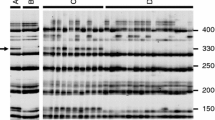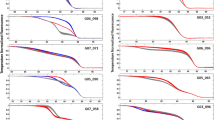Abstract
Three Raphanus populations (BC1, F2 and R8) each segregating for the restoration of Ogura CMS were used tomap restorer loci. The three restorer loci, Rf1, Rf2 and Rf3, each exhibited dominant restoring alleles and wereeach mutually epistatic. Rf1 was mapped to the upper region of Rs1 using data from each population. Rf2 wasmapped to the middle of Rs2 using both the F2 and R8 populations. Rf3 was mapped to the upper region of Rs7using the R8 population. The marker analysis and linkage mapping of the BC1 and F2 populations were describedpreviously (Bett and Lydiate, 2003). Scoring at 114 marker loci in R8 population allowed a new map ofthe Raphanus genome to be integrated with the consensus map. The complex genetic control of the restoration ofOgura CMS in Raphanus is compared with the more simple genetic control of this trait previously described inB. napus. Markers linked to each of the three restorer loci will allow the routine generation and verification ofdefined restorer and maintainer lines for various combinations of defined restorer loci. Although the restorationof Ogura CMS in Raphanus probably involves additional loci, the identification of three loci and diagnosticmarkers for each provides a solid foundation for the development of a holistic model for the genetic control ofthis trait through mapping in additional populations.
Similar content being viewed by others
References
Bett K.E. 2001. Genome analysis and genetic mapping of restorer loci in Raphanus. PhD thesis, University of Saskatchewan, Canada.
Bett K.E. and Lydiate D.J. 2003. Genetic analysis and genome mapping in Raphanus. Genome 46: 423–430. (accepted Feb. 2003).
Bonhomme S., Budar F., Lancelin D., Small I., Defrance M.-C. and Pelletier G. 1992. Sequence and transcript analysis of the Nco2.5 Ogura-specific fragment correlated with cytoplasmic male sterility in Brassica cybrids. Mol. Gen. Genet. 235: 340–348.
Bonnet A. 1975. Introduction et utilisation d'une stérilité mâle cytoplasmique dans des variétés précoces Européennes de radis, Raphanus sativus L. Ann. Amélior. Plantes 25: 381–397.
Delourme R. and Eber F. 1992. Linkage between an isozyme marker and a restorer gene in radish cytoplasmic male sterility of rapeseed (Brassica napus L.). Theor. Appl. Genet. 85: 222–228.
Delourme R., Bouchereau A., Hubert N., Renard M. and Landry B.S. 1994. Identification of RAPD markers linked to a fertility restorer gene for the Ogura radish cytoplasmic male sterility of rapeseed (Brassica napus L.). Theor. Appl. Genet. 88: 741–748.
Dill Carren L., Wise R.P. and Schnable P.S. 1997. Rf8 and Rf* mediate unique T-urf13-transcript accumulation, revealing a conserved motif associated with RNA processing and restoration of pollen fertility in T-cytoplasm maize. Genetics 147: 1367–1379.
Hansen M., Halldén C., Nilsson N.-O. and Säll T. 1997. Marker-assisted selection of restored male-fertile Brassica napus plants using a set of dominant RAPD markers. Molec. Breed. 3: 449–456.
Hawlader M.S.H., Mian M.A.K. and Ali M. 1997. Identification of male sterility maintainer lines for Ogura radish (Raphanus sativus L.). Euphytica 96: 297–300.
Humaydan H.S. and Williams P.H. 1976. Inheritance of seven characters in Raphanus sativus L. (Radishes). HortSci. 11: 146–147.
Koizuka N., Imai R., Iwabuchi M., Sakai T. 2000. Genetic analysis of fertility restoration and accumulation of ORF125 mitochondrial protein in the kosena radish (Raphanus sativus cv. Kosena) and a Brassica napus restorer line. Theor. Appl. Genet. 100: 949–955.
Krishnasamy S. and Makaroff C.A. 1993. Characterization of the radish mitochondrial orfB locus: possible relationship with male sterility in Ogura radish. Curr. Genet. 24: 156–163.
Murayama S., Habuchi T., Yamagishi H. and Terachi T. 2003. Identification of a sequence-tagged site (STS) marker linked to a restorer gene for Ogura cytoplasmic male sterility in radish (Raphanus sativus L.) by non-radioactive AFLP analysis. Euphytica 129: 61–68.
Niewhof M. 1990. Cytoplasmic-genetic male sterility in radish (Raphanus sativus L.). Identification of maintainers, inheritance of male sterility and effect of environmental factors. Euphytica 47: 171–177.
Ogura H. 1968. Studies on the new male-sterility in Japanese radish, with special reference to the utilization of this sterility towards the practical raising of hybrid seeds. Mem. Fac. Agric. Kagoshima Univ. 6: 39–78.
Pelletier G., Primard C., Vedel F., Chetrit P., Renard M., Pellan-Delourme R. and Mesquida J. 1987. Molecular phenotypic and genetic characterization of mitochondrial recombinants in rape-seed. Proc. 7th Int. Rapeseed Congress. Poznan, Poland. pp 113–118.
Sharpe A.G., Parkin I.A.P., Keith D.J. and Lydiate D.J. 1995. Frequent nonreciprocal translocations in the amphidiploid genome of oilseed rape (Brassica napus). Genome, 38: 1112–1121.
Snyder R.J. and Duvik D.N. 1969. Chromosomal location of Rf2, a restorer gene for cytoplasmic pollen sterile maize. Crop Sci. 9: 156–157.
Wise R.P., Gobelman-Werner K., Pei D., Dill C.L. and Schnable P.S. 1999. Mitochondrial transcript processing and restoration of male fertility in T-cytoplasm maize. J. of Heredity 90: 380–385.
Yamagishi H. 1998. Distribution and allelism of restorer genes for Ogura cytoplasmic male sterility in wild and cultivated radishes. Genes Genet. Syst. 73: 79–83.
Yamagishi H. and Terachi T. 1994a. Molecular and biological studies on male sterile cytoplasm in Cruciferae. II. The origin of Ogura male sterile cytoplasm inferred from the segregation pattern of male sterility in the F1 progeny of wild and cultivated radishes (Raphanus sativus L.). Euphytica. 80: 201–206.
Yamagishi H. and Terachi T. 1994b. Molecular and biological studies on male sterile cytoplasm in Cruciferae. II. The origin of Ogura male sterile cytoplasm inferred from the segregation pattern of male sterility in the F1 progeny of wild and cultivated radishes (Raphanus sativus L.). Euphytica. 80: 201–206.
Yamagishi H. and Terachi T. 1996. Molecular and biological studies on male-sterile cytoplasm in Cruciferae. III. Distribution of Ogura-type cytoplasm among Japanese wild radishes and Asian radish cultivars. Theor. Appl. Genet. 93: 325–332.
Yamagishi H. and Terachi T. 1997. Molecular and biological studies on male-sterile cytoplasm in Cruciferae. IV. Ogura-type cytoplasm found in wild radish, Raphanus raphanistrum. Plant Breeding 116: 323–329.
Author information
Authors and Affiliations
Corresponding author
Rights and permissions
About this article
Cite this article
Bett, K.E., Lydiate, D.J. Mapping and Genetic Characterization of Loci Controlling the Restoration of Male Fertility in Ogura CMS Radish. Molecular Breeding 13, 125–133 (2004). https://doi.org/10.1023/B:MOLB.0000018759.27223.02
Issue Date:
DOI: https://doi.org/10.1023/B:MOLB.0000018759.27223.02




